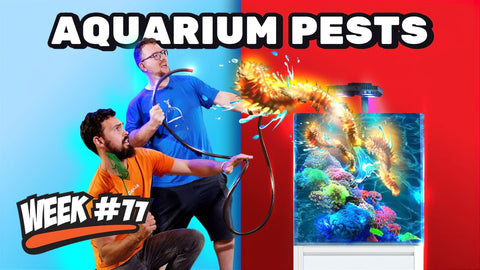Best Rocks For Your Saltwater Aquarium | 12 Week Reef Video Tutorial #2
How to Start a Reef Tank: Aquascaping & What's The Best Rocks For Saltwater Aquariums – Week 2
Welcome back to the 12-week reef tank adventure! We’ve officially reached Week 2, and it’s time to jump into one of the most exciting parts of starting a reef tank: aquascaping and setting up the habitat. This week, you’ll be focusing on the essential choices for substrate, rocks, and creating the perfect aquascape for your saltwater aquarium. Let’s get started!
Step 1: Bare Bottom vs. Sand Substrate – What’s Right for Your Reef Tank?
Before you can start aquascaping, you’ll need to decide on the foundation of your tank: bare bottom or sand substrate. Both have their pros and cons, and your choice will largely depend on your personal preferences and the type of coral and fish you plan to keep.
-
Bare Bottom Aquarium: Ideal for those who prioritize easy maintenance and water flow. Without sand, there’s less detritus build-up, and you can glue corals directly onto the tank’s surface, allowing them to spread naturally. Bare bottom setups are popular among reef tank enthusiasts who focus on high-flow corals. Plus, they are much easier to clean!
-
Sand Substrate: If you're after a more natural look, a sand substrate can create a beautiful, realistic reef environment. Sand is great for burrowing fish and invertebrates, and it aids in biological filtration, promoting a healthy nitrogen cycle. Although cleaning sand can be a bit more labor-intensive, it provides a more diverse habitat for both corals and fish.
For our tank, we’ve chosen sand as it offers the best of both worlds—a natural appearance and ample space for a variety of fish and corals. It’s important to note that we didn’t wash the sand before adding it to the tank. Instead, we’ll rely on filter socks to clean it out during the cycling process.
Step 2: Live Rock vs. Dry Rock – Building the Perfect Reef
Now that the substrate is in, it’s time to talk rock selection. There are two main types of rock to choose from when setting up a reef tank:
-
Live Rock: Collected directly from coral reefs, live rock is teeming with beneficial bacteria, microfauna, and sometimes hitchhikers—good and bad. It’s a fantastic way to jumpstart the nitrogen cycle in your tank, but it can be expensive and may introduce unwanted pests like Aiptasia, hitchhikers and flatworms.
-
Dry Rock: A more eco-friendly option, dry rock is free from live organisms and is much easier to handle in terms of scaping. It doesn’t offer the immediate biological boost that live rock does, but it’s affordable, easy to work with, and doesn’t carry any risk of unwanted hitchhikers.
For this build, we’ve chosen Marco Rocks dry rock. These rocks offer the best balance between affordability, aesthetic appeal, and surface area for biological filtration. They also make aquascaping easier, especially for creating arches, ledges, and caves.
Step 3: Aquascaping – Creating a Beautiful, Functional Reef Tank
Now comes the fun part—aquascaping! When you’re deciding how to arrange your rocks, it’s essential to balance both form and function. The goal is to create a visually appealing reef while providing ample space for fish to swim and corals to grow. Here are a few key tips for aquascaping your reef tank:
-
Plan Your Rock Layout: We're aiming for an open, ledge-style aquascape to encourage good water flow and provide plenty of hiding spots for fish. Arches and caves add dimension to your scape and help fish feel more secure.
-
Less Is More: While it’s tempting to add lots of rocks, remember that too much rock can restrict water flow and create dead spots where detritus can accumulate. For our 2-foot, 200L (50 gallons) tank, we’ve chosen around 20kg of Marco rock to maintain a balanced, open layout.
-
Aquascaping Glue & Cement: To create stable structures, we’re using DALUA aquascaping glue. These tools will help lock your rocks into place, ensuring your aquascape is safe and secure.
Pro Tips for Aquascaping Success
-
Work Outdoors: If possible, assemble your rock structures outside. Aquascaping glue and dust can be irritating, so it’s best to work in a well-ventilated area.
-
Choose Rocks That Stand Out: Pick rocks with interesting shapes that will add variety to your scape. Marco Rocks offers natural shapes that are perfect for building a dynamic, natural-looking reef tank.
-
Balance Aesthetics & Functionality: Your aquascape should not only look good but also provide ample hiding spots and surfaces for coral growth. Arches, caves, and ledges are excellent for this.
Saltwater Aquarium Best Start Guide
In the coming weeks, we’ll dive into topics like:





